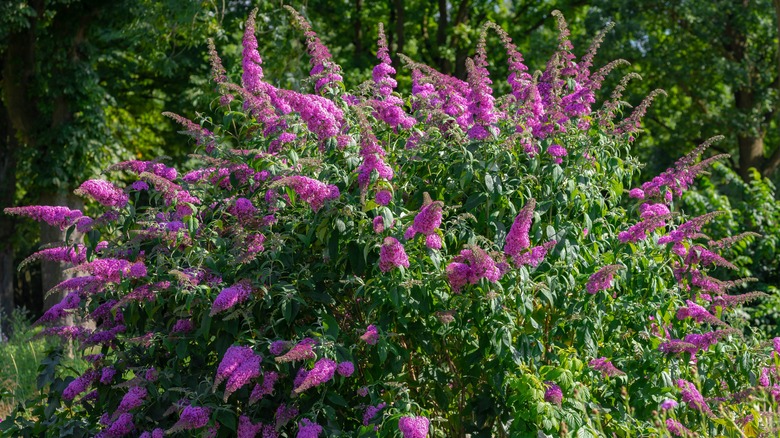The butterfly bush (Buddleja davidii) is a beautiful specimen that’s native to China, and it is a producer of exorbitant amounts of pollen that attract countless pollinators. While on the surface this might seem innocent enough, this bush is actually very invasive and could quickly overtake a garden or yard. Most people are at least somewhat aware of the catastrophic damage invasive species can do when left unchecked, and the butterfly bush is no exception. There are also a few other negative characteristics that you should know about before praising this plant.
Many gardeners love having a butterfly bush in their garden, and it’s easy to see why! They produce gorgeous, cone-shaped, typically purple or pink flowers that butterflies of all kinds flock to, like a light that attracts flying insects at night. The blooms are bountiful and last from summer to fall. Once they’re established, they don’t require much in the way of maintenance. It’s perfectly natural to mistakenly believe that by having one, you’re positively affecting the ecosystem. Unfortunately, the bitter truth is that in the long run, you’re probably harming the butterfly population and native plants instead.
It’s an invasive plant that isn’t so great for butterflies

The biggest problem with the butterfly bush is that it’s an invasive species. In order for a species to be considered invasive, it must meet certain criteria. For example, it must adapt easily to relocation and reproduce quickly. It must also harm property and/or native plants and animals. Butterfly bushes are considered invasive because they take over other native species in the wild and can cause great harm to the environment. Sometimes the effects are unpredictable and especially devastating. These plants can result in the extinction of native species and wildlife on a grand scale. Further, a single flower spike on a butterfly bush can produce over 40,000 seeds that can travel long distances and remain viable in the soil for five years, so this plant is very difficult to get rid of.
Because butterflies and other pollinators typically flock to this plant, other nearby plants may not become pollinated and could suffer. Furthermore, while butterfly bushes attract butterflies, they can’t support their caterpillars, meaning that they can’t lay their eggs on them. So when butterfly bushes are the only pollinators around because they literally choked the life out of all the native species, the butterflies can’t reproduce and their numbers decrease.
What to plant instead
Luckily, you have other choices when searching for something that attracts butterflies and other pollinators. For instance, the Gayfeather (Liatris spicata) also has beautiful, purple-colored blooms. This perennial sports stunning flowers that look like purple feathers and show up around mid-summer. They’re easy to grow and do well with other plants, unlike the butterfly bush. The best thing about the Gayfeather is that it attracts butterflies, hummingbirds, and bees.
Another terrific choice is the Buttonbush (Cephalanthus occidentalis), which boasts cylinder-shaped white blooms and can grow up to 12 feet tall. There are smaller versions too, if you’re limited on space. This bush is lovely and attracts butterflies, bees, songbirds, hummingbirds, and some species of butterflies can lay their eggs on this plant.
Last but not least, try the Coneflower (Echinacea) for its lovely petals that come in many colors with cone-shaped centers that pollinators love. This perennial will thrive nearly anywhere in the United States. It can tolerate both harsh winters and is also drought-resistant. It attracts pollinators like butterflies, bees, and birds. Any of these suggestions will make a much better and environmentally-conscious choice for your garden than the butterfly bush.